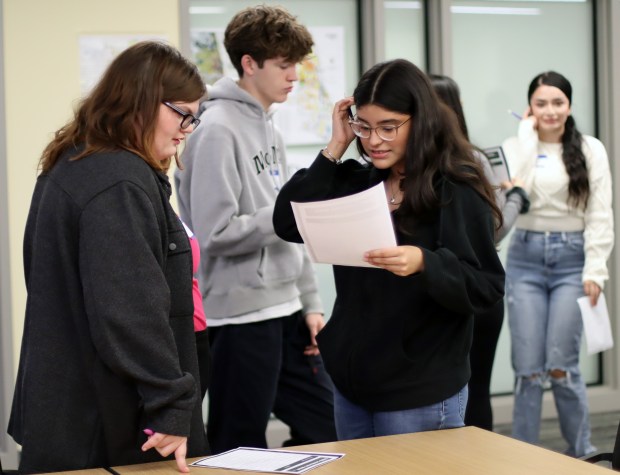Looking at maps with red, green and yellow areas marked off, students from Waukegan and New Trier Township high schools learned together about redlining and housing discrimination in their backyards as part of their advanced placement African American studies course.
“There was a small, tiny red area where African Americans lived in Glencoe,” Clifford Turner, who teaches the course in Waukegan, said.
Though there was once an African American neighborhood in Glencoe, Michael Christensen, the social studies chair at New Trier, said gentrification eventually pushed the original homeowners out. Finding a mortgage with reasonable terms was harder in the red areas.
Students from the African American studies classes at Waukegan and New Trier held a joint class on Nov. 19 on New Trier’s Winnetka campus, spending some of the time teaching each other about the history of housing discrimination along the lakefront north of Chicago.
Recognized nationally by the College Board as a pilot program two years ago, Christensen said few schools in the area offer it. She said she and Turner began communicating after a meeting last year and hatched the idea of bringing their classes together.
“There is value in students getting to know each other from other schools and sharing ideas,” Christensen said. “Students from Waukegan and New Trier look at things from different perspectives.”
Turner said that in the spring, the New Trier students will spend time in a Waukegan classroom focusing on segregation in Waukegan’s public schools in the 1950s and 1960s, before the Illinois Supreme Court ended it in 1966.
“The students need to know it was something that happened here in Waukegan,” Turner said. “They can learn from each other. They can learn the nuances of different cultures.”
When the joint class started in Winnetka, Christensen said she divided students into small groups to look at the maps around the room. Red showed areas in the 1950s and 1960s where Blacks lived, and green indicated a white population. Jacara Smith, a Waukegan senior, was in a group.
“The red was in areas where it was less desirable to live,” Smith said. “It was like the cultures didn’t mix. The Hispanics and Blacks aren’t in the areas near the lake. You really saw a difference.”

As the students from the two schools interacted, Smith said they got to know each other on a personal level, discussing issues which impacted both of their communities at roughly the same time in history.
When the course was first approved as a national advanced placement pilot program, Christensen said New Trier, Evanston and Waukegan, were among the few local schools offering it. Turner said when the school year began in August, he taught his students about the people of Africa.
“You don’t realize how diverse the population is,” Turner said. “As we talked about the diaspora, we learned how diverse it was here. We talked about resistance as a people, and how they are still trying to overcome something.”
Karl Guerrier, a Waukegan senior, comes at African American history from a different angle. Black and Haitian, he arrived in the United States from nearly-all-Black Haiti in 2021. He is now a member of a minority. He took the course to learn more about being Black in America.
“It’s very different,” Guerrier said. “I rarely saw white people, and it was for a very limited time. Every day I see something different (now), and learn something different. This course is an opportunity to learn about different cultures.”
As an advanced placement class, Turner said at the end of the school year, the students will take a national standardized test. If they score well enough, they will get college credit for the class. Last year, 83% of the students taking the course made the grade.





